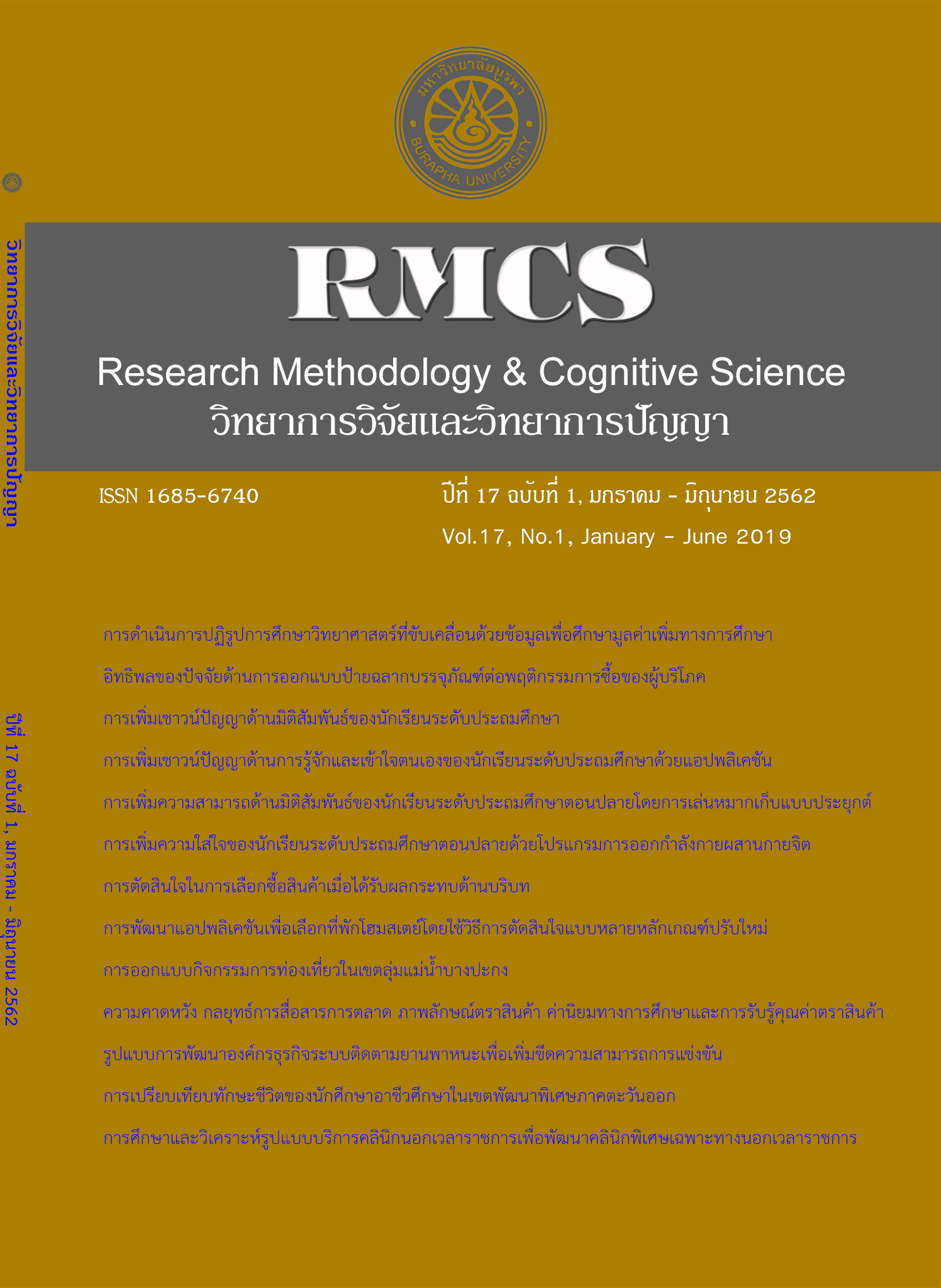Enhancing Intrapersonal Intelligence among Primary School Students Using Intrapersonal Training Application: Behavioral Study
Main Article Content
Abstract
The purposes of this study were to investigate the effect of the developed intrapersonal training application by comparing the different score of Intrapersonal Intelligence between pre-and-posttest within experimental groups between groups on gender and general intelligence, by comparing the response accuracy score and response time on intrapersonal intelligence test, before and after using training application. The eighty primary students were recruited and divided into four groups. The study was a Factorial design. The instrument consisted of 1) the intrapersonal training application, 2) the paper-pencil Intrapersonal intelligence and computerized Intrapersonal intelligence test, Data were analyzed using mean, standard deviation, t-test and two-way ANOVA.
The results demonstrated that results of using the intrapersonal training application being measured from a paper-and-pencil and computerized intrapersonal intelligence tests found that intelligence scores after the experiment were higher than before the experiment (p<.01). There were significantly differences between gender on the interpersonal intelligence score (paper-and-pencil based test) and between high and low general intelligence on the interpersonal intelligence score (computerized based test). There was an interaction effect between sex and general intelligence on the interpersonal intelligence score for both paper-and-pencil and computerized based tests
In conclusion, the intrapersonal training application could enhance the intrapersonal intelligence of primary school students.
Article Details
References
Anderman, E. M., & Mueller, C. (2010). Middle school transitions and adolescent development. In L. M. Judith, & S. E. Jacquelynne (Eds.), Handbook of research on schools, schooling, and human development (pp. 198-215). New York: Routledge.
Armstrong, T. (2018). Multiple Intelligences in The Classroom (4th ed.). Alexandria, Virginnia: ASCD.
Baxter, J. A. (2012). Who am I and what keeps me going? Profiling the distance learning student in higher education. The International Review of Research in Open and Distances Learning, 13(4), 107-129.
Dennis, T. A., Melville, M. M., & Chen, C. (2009). emotional face processing and emotion regulation in children: An ERP Study. Developmental Neuropsychology, 34(1), 85-102.
Edmonds, A. W. & Kennedy, D. T. (2017). An applied guide to research designs quantitative, qualitative, and mixed methods (2nd ed.). California: SAGE Publication.
Emmiyati, N., Rasyid, M. A., Rahman, M. A., Arsyad, A., & Dirawan, G. D. (2014). Multiple intelligences profiles of junior secondary school students in indonesia. International Education Studies, 7(11), 103-110.
Gardner, H. (2006). Multiple intelligences new horizons. New York: Basic Books.
Gardner, H. (2011). Frames of mind: The theory of multiple intelligences (3rd ed.). New York: Basic Books.
Giedd, N., J. (2017). The amazing teen brain. Scientific American, 312(6), 32-37.
Gur, E. R, Gur, C. R (2016). Sex differences in brain and behavior in adolescence: Findings from the Philadelphia Neurodevelopmental Corhort. Neuroscience and Biobehavioral Reviews, 70(1), 159-170.
Habeeb, T. K., & Fatema, M. (2016). Effect of intrapersonal and interpersonal awareness dimensions of emotional intelligence on stress management of adolescents. International Journal of Applied Research, 2(10), 589-592.
Kim, Y. H., & Ham, J. H. (2016). A study on ways to connect Multiple Intelligence Theory and ‘Thinking and Expression’ Course. Asia-Pacific Journal of Educational Management Research, 1(13), 81-86.
Mayer, J. D., Caruso, D. R., Panter, A. T., & Salovey, P. (2012). The growing significance of hot intelligences. American Psychologist, 67(6), 502-503.
Mckenzie, Walter. (2012). Intelligence quest: project-based learning and multiple Intelligences (1st ed.). New York: ISTE.
Mowat, J. G. (2011). The development of intrapersonal intelligence in pupils experiencing social, emotional and behavioural difficulties. Educational Psychology in Practice, 27(3), 227-253.
National Research Council. (2011). Assessing 21st Century skills: Summary of a workshop. Washington: The National Academies Press.
Perez, P. M, & Ruz, R. N. (2014). Intrapersonal Intelligence and motivation in foreign language learning. European Scientific Journal, 10(17), 142-150.
Sellars, M. (2012). Exploring executive function: Multiple intelligences' personalized mapping for success. International Journal of Learning, 18(3), 293-304.
Shearer, B. (1996). The MIDAS: A professional manual (4th ed.). Ohio: Multiple Intelligences Research and Consulting.
Shek, T. L., Sun, C. F., Yuen, W. H., Chui, H. Y., & Dorcas, A. (2013). Second piloting of a leadership and intrapersonal development subject at the Hong Kong Polytechnic University. In T. L. Daniel, C. F., Rachel, & J. Merrick, (Eds.), Chiness Adolescent Development: Economic Disadvantage, Parents and Intrapersonal Development (pp. 111-123). Hong Kong: Nova Science Pulishers.
Chen, S. K., Hwang, F. M., Yeh, Y. C., & Lin, S. S. (2012). Cognitive ability, academic achievement and academic self-concept: Extending the internal/external frame of reference model. British Journal of Educational Psychology, 82(2), 308-326.

